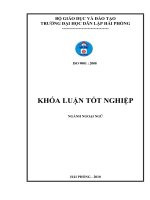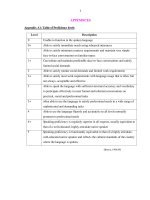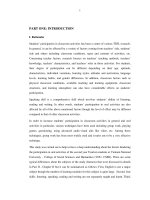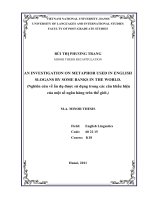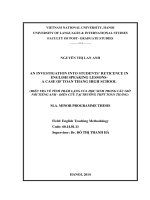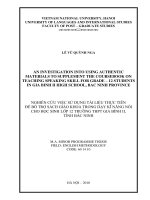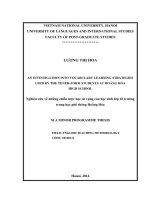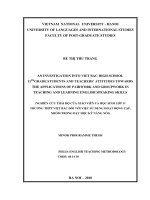An investigation into conditional sentences in english novel “the red and the black” with their vietnamese equivalents
Bạn đang xem bản rút gọn của tài liệu. Xem và tải ngay bản đầy đủ của tài liệu tại đây (1.72 MB, 80 trang )
MINISTRY OF EDUCATION AND TRAINING
HANOI OPEN UNIVERSITY
PHẠM THỊ LAN PHƯƠNG
AN INVESTIGATION INTO CONDITIONAL SENTENCES
IN ENGLISH NOVEL “THE RED AND THE BLACK” WITH
REFERENCE TO THEIR VIETNAMESE EQUIVALENTS
(NGHIÊN CỨU CÂU ĐIỀU KIỆN TRONG TÁC PHẨM VĂN
HỌC “ĐỎ VÀ ĐEN” VÀ TƯƠNG ĐƯƠNG TIẾNG VIỆT)
M.A THESIS
Field: English Language
Code: 8220201
Hanoi, 2018
MINISTRY OF EDUCATION AND TRAINING
HANOI OPEN UNIVERSITY
PHẠM THỊ LAN PHƯƠNG
AN INVESTIGATION INTO CONDITIONAL SENTENCES
IN ENGLISH NOVEL “THE RED AND THE BLACK” WITH
REFERENCE TO THEIR VIETNAMESE EQUIVALENTS
(NGHIÊN CỨU CÂU ĐIỀU KIỆN TRONG TÁC PHẨM VĂN HỌC
“ĐỎ VÀ ĐEN” VÀ TƯƠNG ĐƯƠNG TIẾNG VIỆT)
M.A THESIS
Field: English Language
Code: 8220201
Supervisor: Assoc. Prof. Dr Nguyễn Đăng Sửu
Hanoi, 2018
STATEMENT OF AUTHORSHIP
I, the undersigned, hereby certify my authority of the study project report
entitled An investigation into conditional sentences in English novel “The
Red and The Black” with their Vietnamese equivalents submitted in partial
fulfillment of the requirements for the degree of Master in English Language.
Except where the reference is indicated, no other person’s work has been used
without due acknowledgement in the text of the thesis.
Hanoi, 2018
Pham Thi Lan Phuong
Approved by
SUPERVISOR
Assoc. Prof. Dr. NGUYỄN ĐĂNG SỬU
Date:……………………
ACKNOWLEDGEMENTS
A piece of work of this magnitude is never the effort of only an
individual. Surely, this thesis could not be either begun or completed without
the help, inspiration and moral support of many people. I would like to thank
them all here.
This work owes its existence to my supervisor Assoc. Prof. Dr. Nguyễn
Đăng Sửu, the discussion with whom opened my eyes to the complexity of
conditionals. From him I have learned more than I could have ever done the work
alone. His guidance and positive criticism helped to give shape to this work. I am
grateful to him.
I would like to express my gratitude to all lecturers of the Faculty of
Graduated Studies, Hanoi Open University for their help, concern and support
during the time I am studying.
I would also like to send my thanks to all my classmates of NNA6.2 who
willingly helped me to accomplish this thesis in many aspects.
Last but not least, I would like to express my heartfelt gratitude to my
family members who have constantly supported, inspired and encouraged me to
complete the graduation paper. Without their love and dedication, this academic
work would not be translated into reality.
ABSTRACT
This thesis discusses about the English conditional sentences in the novel “The
Red and the Black” by Stendhal. The research is conducted to examine the
structures and usage of conditional sentences in English, find out all kinds of
conditional sentences being employed in this novel and its Vietnamese equivalents,
then discuss as well as suggest some implications related to translating English
conditional sentences to Vietnamese teachers and learners. The research is the
mixed of qualitative and quantitative approaches. The source of data is the novel
“The Red and the Black” by Stendhal. The main data are conditional sentences in
the novel. To support the main data, the research is supported by other data taken
from internet and grammar books about conditional sentences. In order to attain the
purpose, the data is analyzed through descriptive and contrastive methods. We have
studied the basic types and most common forms of 153 conditional sentences in the
novel, which prove to have a complex constitution, a wide variety of forms,
exceptions and functions. Semantically, the most frequent type is the first one which
indicates the possibilities in the present or in the future. There are some
implications have been listed to help Vietnamese teachers and learners of English
overcome the difficulties in using and translating English conditional sentences.
LIST OF FIGURES
Figure 1: Classification of Mood ………………………………...………….…….12
Figure 2: Classification of Tense ............................................................................ .14
Figure 3: The Zero conditional with the same tense in both clauses
…………..20
Figure 4: The First conditional sentences (also called type1)............................ .20
Figure 5: The Second conditional sentences (also called type2) ....................... .21
Figure 6: The Third conditional sentences (also called type3) .......................... .21
Figure 7: Types of English Conditional Sentences and their basic syntactic features
................................................................................................................................. .22
Figure 8: Type of mixed conditional sentences ................................................. .23
Figure 9: The frequency of basic types of conditional sentences in the novel
…….39
Figure 10: The appearance of modal verbs can, could, shall, may in conditional
sentences.................................................................................................................. .41
Figure 11: The appearance of modal verbs must, should, might in conditional
sentences.................................................................................................................. .42
TABLE OF CONTENTS
Certificate of originality
Acknowledgements
Abstract
List of figures
CHAPTER I. INTRODUCTION
1.1. Rationale for the study ………………………………………………………....1
1.2. Aims and objectives of the study ....................................................................... .1
1.3. Research questions ………………………………………………………..........2
1.4. Methods of the study .......................................................................................... .2
1.5. Scope of the study ……………………………………………………………...2
1.6. Significance of the study .................................................................................... .2
1.7. Design of the study …………………………………………………………….3
CHAPTER II. LITERATURE REVIEW
2.1. Review of previous studies ................................................................................ .4
2.1.1. Previous researches overseas .......................................................................... .4
2.1.2. Previous researches in Vietnam… .................................................................. .5
2.2. Review of theoretical background .................................................................... .5
2.2.1. English sentence ……………………………………………………………..5
2.2.1.1. Definition …………………………………………………………………. 5
2.2.1.2. Types of English sentence ………………………………………………… 6
2.2.2. Mood ………………………………………………..………………………..9
2.2.2.1. Concept of Mood ………………….………………………………………. 9
2.2.2.2. Types of Mood ……………………….……………………………………..9
2.2.3. Tense ………………………………………………………………………..12
2.2.3.1. Concept of tense ………………………….……………………………….12
2.2.3.2. Types of tense ……………………………………………………………..12
2.2.4. The English conditional sentence ................................................................ ..14
2.2.4.1. Definition of conditional sentence ………………………………………..14
2.2.4.2. A semantic overview of conditional sentence ………………………….…15
2.2.4.3. Different classification of conditional sentence ……………………….….19
2.3. Summary of the chapter .................................................................................. .23
CHAPTER III. METHODOLOGY
3.1. Research governing orientations ..................................................................... ..24
3.1.1. Research questions ....................................................................................... ..24
3.1.2. Research setting ........................................................................................... ..24
3.1.3. Research approaches …………………………………………………….….24
3.1.4. Principles for intended data collection and data analysis …………………...25
3.2. Research methods ………………………………………………………….…25
3.2.1. Major methods vs supporting methods ……………………………………..25
3.2.2. Data collection techniques ……………………………………………….…26
3.2.3. Data analysis techniques ……………………………………………………26
3.3. Summary of the chapter …………………………………………………… ...27
CHAPTER IV. FINDINGS AND DISCUSSIONS
4.1. The structural and semantic features of conditional sentences in the novel
and its Vietnamese equivalents …………………………………………………28
4.1.1. The structural features of conditional sentences in the novel ………….…...28
4.1.2. The basic types of conditional sentences in the novel ……………………...29
4.1.2.1. The zero conditional sentences ................................................................. ..29
4.1.2.2. The first conditional sentences .................................................................. ..30
4.1.2.3. The second conditional sentences ............................................................. ..33
4.1.2.4. The third conditional sentences…………………………………………...36
4.1.2.5. The mixed conditional sentences ............................................................... 38
4.2. The features of modal verbs in the conditional sentences in the novel ……...40
4.2.1. The first conditional sentence with modal verbs …………..……..………..40
4.2.2. The second conditional sentences with modal verbs …..…………………..40
4.2.3. Third conditional sentences with modal verbs ……………………………..41
4.3. Suggestions for translating conditional sentences in the novel ……………….42
4.3.1. Supplying learners with adequate knowledge of types of English conditional
sentences and their Vietnamese equivalents ……………………………………....42
4.3.1.1. Unreal conditionals in the present ………………………………………..42
4.3.1.2. Unreal conditionals in the past …………..……………………………….43
4.3.1.3. Mixed conditionals ……………………….. ……………………………...43
4.3.1.4. Conditional inversions ……………………………….…………………...44
4.3.2. Supplying learners with adequate knowledge of pragmatic functions ……..45
4.3.3 Supplying with adequate knowledge of situational contexts ………………..48
4.4. Summary of the chapter ………………………………………………………49
CHAPTER V. CONCLUSIONS
5.1. Recapitulation……… ..................................................................................... ..50
5.2. Concluding remarks ....................................................................................... ..50
5.3. Limitations of the current research ................................................................ ..51
5.4. Recommendations for further research …………………………………….…51
REFERENCES
APPENDICES
CHAPTER I. INTRODUCTION
1.1. Rationale
Nowadays, English has been spoken all over the world as an international
language. No one can deny that English plays an important role in social life. It is
widely used in every field of life such as science, technology, foreign trade, tourism,
business, education and so on. In Vietnam, it is now a great demand to learn English
for the process of integrating into regional and international economic and diplomatic
development. Moreover, English enables us to communicate with people from different
countries and understand more about their tradition and culture. However, to many
Vietnamese learners who have been learning English for a long time, English
grammar still seems to be a puzzle. Among a number of complex problems,
conditional sentences are really a challenge. They are difficult because of their
complicated structures with two clauses: subordinate clause or if-clause and main
clause. In addition, there are many variations which may cause confusion. The
meanings of conditional sentences are subtle; therefore in order to understand them,
we need to be sensitive enough. Moreover, any conditional sentence is a
combination of tense and a range of auxiliaries which require learners to grasp
before being able to understand and use it.
For the above reasons, the main aim of this paper is to examine the structures
and semantic functions of conditional sentences in English and Vietnamese in the
novel “The Red and the Black” by Stendhal. The author will find out all kinds of
conditional sentences being employed in this novel and its Vietnamese equivalents
and then discuss as well as suggest some implications related to translating English
conditional sentences to Vietnamese learners. The writer hopes this will be a useful
references for both teachers of English and learners.
1.2. Aims and objectives of the research
* Aims of the research
The study is expected to offer an overview of English conditional sentences by
means of descriptive and contrastive methods through the novel “The Red and the
Black” by Stendhal and then to provide Vietnamese learners with the deeper
understanding of English conditional sentences and some ways to help them
overcome the difficulties in translating them.
* Objectives of the research
In order to achieve the aims, the author has set a number of objectives to be
1
accomplished during the process of conducting this study:
- Firstly, identifying structural features of the types of conditional sentences
employed in the novel “The Red and the Black” and their Vietnamese equivalents.
- Secondly, pointing out the semantic functions of conditional sentences used in the
novel and its Vietnamese equivalents.
- And lastly, suggesting some implications for translating English conditional
sentences used in the novel.
1.3. Research questions
In order to attain the aims, the study will seek to answer the following questions:
- What are the structural features of the types of conditional sentences employed in
the novel “The red and the black” and their Vietnamese equivalents?
- What are the semantic functions of conditional sentences used in the novel and
their Vietnamese equivalents?
- What are the suggestions for translating English conditional sentences in the
novel?
1.4. Methods of the study
Descriptive and analytical methods are also used in the study. Description is
intended to follow a qualitative approach. After the data are collected, the
description of the translation of conditional sentences is given.
- Firstly, the author reviews the data collected from different sources relating to
English and Vietnamese conditional sentences.
- Secondly, English conditional sentences selected from the novel “The red and the
black” (Book 1) will be described, analyzed and compared in order to find out the
similarities and differences in both English and Vietnamese conditional sentence.
- Finally, the research results will be discussed so as to present some suggestions to
help Vietnamese learners use conditional sentences effectively.
1.5. Scope of the study
Due to limitation of time, reference and capacity, 153 conditional sentences in
the novel “The red and the black” by Stendhal are examined, classified into
different kinds, compared with Vietnamese equivalents then brings out some
suggestions to help those who are interested in conditionals in translating this
particular kind of the sentence.
1.6. Significance of the study
This study focuses on describing and analyzing the structures and usage of
2
English conditional sentences described in grammatical books, then examining the
usage of them in different communication circumstances in the novel “The red and
the black”. Besides, the paper will also find out the frequency of conditional
sentences in the novel to hypothesize the presence of these conditional sentences
and its Vietnamese equivalents. Last but not least, the paper suggests some
suggestions for translating English conditional sentences.
1.7. Design of the study
This study is comprised of the following chapters:
Chapter 1 is an introduction presenting some background information and the
rationale of the study. The aims, objectives, the scope, the significance and method
of the study are also dealt with in this chapter.
Chapter 2 is aimed at presenting the theoretical background of the work. Some
essential concepts closely related to the study are carefully discussed one by one.
Chapter 3 explains what methods are employed for data collection and analysis,
looks at the selection of subjects and the procedures of data collection and analysis.
Chapter 4 finds out the basic types and most common forms of conditional
sentences that appear in the novel, the frequency of conditional sentences and its
Vietnamese equivalents, then, some implications for translating English conditional
sentences are also suggested.
Chapter 5 gives conclusion, refers to the limitations and suggests further research
3
CHAPTER II. LITERATURE REVIEW
2.1. Review of previous studies
2.2.1. Previous researches overseas
From functional grammar point of view, through investigating some projects
such as A Practical English Grammar (A.J.Thomson, A.V.Martinet, 1986), English
Grammar in Use (Raymond Murphy, 1994), Advanced English Practice (B.D
Graver, 1986), Understanding and Using English Grammar (Betty Schrampfer
Azar, 1998) and Oxford Guide to English Grammar (John Eastwood, 1997), we
realized that conditional sentences were put into different types based on two
criteria: physicalism (real, unreal) and time (past, future, present). There are three
basic types:
Type 1 – open conditional sentences and real conditional sentences
Type 2 – unreal conditional sentences and hypothetical condition
Type 3 – unreal condition in the past
Moreover, B.D Graver and John Eastwood also added type 0 in order to
indicate condition – consequence. Meanwhile, A.V.Martinet and Betty Schrampfer
Azar put it into type 1 as the automatic consequences, habit and truth. In addition,
A.V.Martinet, Betty Schrampfer Azar and John Eastwood talked about mix type
such as 1-3, 2-3, 3-2.
In universal grammar, the linguists such as Fillmore (1986), Langacker
(1987), Sweetser have applied prototype theory on linguistic analyses. Eve
Sweetser, in From Etymology to Pragmatics (1990) classified conditional semantics
according to the three domains she speaks of the content domain, the epistemic
domain, and the speech act domain in that book.
Content-based conditionals are understood by relating the content of the two
clauses to each other. A typical way in which content conditionals can be
understood is for the "P" clause to identify a situation which causes or automatically
results in the state of affairs signaled by the "Q" clause.
Grammar books agree that there are three or four main types of conditional
clauses. Quirk et al (A Comprehensive Grammar of the English Language)
distinguished four main types such as the Zero (Cause and Effect) Conditional, the
First (Open) Conditional, the Second (Unreal) Conditional and the Third
Conditional.
4
2.1.2. Previous researches in Vietnam
Dang Thi Huong (Practical English Grammar, 1998) approached the
conditions from the view of two separation clauses and Mood categories.
Specifically, the authors suggested that the IF clause was divided into two
categories, depending on the speaker's conception, the indicative and Subjunctive
(based on the correlation of tense and time); the main clause included Infinitive and
Modal and would be changed if it referred to the past, present or future. This system
came from the perspective of theory and conditional problem was solved flexibly.
However, when applied in practice, this approach is obviously difficult for the
readers who are not English majors.
Võ Thị Kim Anh (Different Ways to Express Condition and Concession in
English and Vietnamese - M.A thesis, 2010) stated that condition-consequence
relation is often described as “If P then Q”. Her article just focused on conditionconsequence expressed by subordinating conjunctions.
In short, there have been various studies on conditional sentences in general
from an article, a scientific research to a graduation paper or a book. However, all
the authors only focus on the types and meanings, there’s hardly any research into
conditional sentences in a novel. For this reason, our research is an endeavor to
examine the problem of conditional sentences in English grammar and novels.
2.2. Review of theoretical background
2.2.1. English sentence
2.2.1.1. Definition of English sentence
There are a number of sentence definitions given by different grammarians.
According to L.G. Alexander (1988:2), a sentence is defined as “a complete unit of
meaning. When we speak, our sentence may be extremely involved or even
unfinished, yet we can still convey our meaning through intonation gesture, facial
expression, etc. When we write, these devices are not available, so sentences have
to be carefully structured and punctuated. A written sentence must begin with a
capital letter and end with a full stop (.), a question mark (?) or an explanation
mark (!)".
Roloff and Brosseit in the book “Sentences” (1979:13) writes "sentence is a
group of related words that expresses a complete and meaningful thought; either a
statement, a question, a command or an exclamation".
In addition, the "New Webster's expanded dictionary" states, "Sentence is an
5
opinion, a maxim, a judgment, a number of words containing complete sense".
In short, a sentence is a group of words that you use to communicate ideas in
writing or in speaking. Every sentence is composed of one or more clauses and
expresses a complete thought.
According to Randolph Quirk and Sidney Greenbaum (1987:12), a sentence
may alternatively be seen as comprising five units called elements of structure:
subject, verb, complement, object, adverbial abbreviated respectively as S, V, C, O,
A.
2.2.1.2. Types of English sentence:
There are different classifications of sentences. They are classified
according to purpose, according to syntax or structure, according to form and
according to completeness.
a. Sentences are classified according to purpose.
They are further classified into declarative sentence, interrogative sentence,
imperative sentence and exclamatory sentence.
The purpose of the declarative sentence is to focus the reader’s attention. It
invites the reader further to consider the assertion made by the predicate about it.
The purpose of the interrogative sentence is to provide assertion with regards
to the concept that is indicated by the questions. With this the reader will be directly
involve with the development of ideas through asking the reader to phrase the
statement.
The purpose of the imperative sentence is to show the desire of the writer
with regards to the topics as well as to the actions that is being indicated. Imperative
sentence involves the reader directly through addressing him or her and asking for a
response.
The purpose of the exclamatory sentence is to show a sudden or strong
feeling about something. In exclamatory sentence, there may be a thought, emotion
or sensation behind. It is used to express judgment, sensation and to express relieve
of an internal pressure and the like.
b. Sentences are classified according to syntax or structure.
These classifications are in the form of simple sentence, compound sentence,
complex sentence and compound-complex sentence.
Simple sentence
A simple sentence is the one that consists of one independent clause. According to
6
Quirk (1976), sentence can be classified into 7 types:
SV: The child laughed.
SVA: Mary is in the house.
SVC: Mary is a nurse.
SVO: Somebody caught the ball.
SVOA: I put the plate on the table.
SVOC: We have proved him a fool.
SVOO: She gives me expensive present
Compound sentence
Most of textbooks (ESL, EFL..) gave a definition about compound sentence as
follows: A compound sentence contains at least two independent clauses, often
joined by a coordinating conjunction.
The coordinating conjunctions are as follows: but, and, nor, either, so, not
only, but also… Except for very short sentences, coordinating conjunctions are
always preceded by a comma.
E.g: I tried to speak Spanish, and my friend tried to speak English.
I played badminton, so you went shopping.
I played badminton, for Thuy went shopping.
The above three sentences are compound sentences. Each sentence contains
two independent clauses, and they are joined by a coordinator with a comma
preceding it.
Complex Sentence
Complex sentence which contains more than one clauses of which one is the
main clause, the others are subordinate clauses being part of the main clause. The
subordinate clauses and main clause are jointed together by subordinating
conjunctions.
* The main clause is a clause which has a meaningful unit by an independent clause
but it also needs one or more subordinate clause complementing for it.
* The subordinate clause (dependent clause) is a clause which has to depend on the
main clause.
- There are many subordinate clauses:
+ Subordinate clause has a function as a noun (noun clause).
E.g: I don’t know / when she will come.
Main clause
noun clause
7
+ Subordinate clause has a function as an adjective (adjective clause).
E.g: This is the magazine / which you ordered.
Main clause
adjective clause
+ Subordinate clause has a function as adverb (adverbial clause)
Adverbial clause show when, where, how, why the action in the main clause
occurring. So, adverbial clause is named basing on function of it:
- Adverbial clause of time shows when the action in the main clause occurring.
E.g: Shut the door / when you leave.
Adverbial clause of time
- Adverbial clause of reason shows why the action in the main clause occurring.
E.g: He couldn’t join the trip / because he was rich.
Adverbial clause of reason
- Adverbial clause of condition shows how the action in the main clause occurring.
E.g: The sun’s activities were not so steady / life on the earth would soon cease.
Adverbial of condition
Compound-complex sentence
The compound-complex sentence seems to be a complicate sentence in
English grammar. As Oshima and Hogue in “writing academic English” published
in 2003 wrote: “A compound-complex sentence is the combination of two or more
independent clauses and once and more dependent clause.”
E.g: I will come and I will bring some of my friends / if they have a day off.
Compound sentence
adverbial clause of condition
Therefore, the conditional sentence is one kind of complex sentence
because it contains a main clause and subordinate clause (if clause) joined together
by subordinating conjunctions such as if, unless…
c. Sentences are classified according to their form.
With this they are further classified into periodic sentence, loose or cumulative
sentence and balance sentence.
The periodic sentence is a form of sentence where the core idea or the main
thought is not completed until the final word.
The loose or cumulative sentence is a form of sentence wherein the subject
and the verb are stated early and whatever additional modifier qualifications or
exemptions are just added.
8
In the balance sentence, the structure and the phrasing of the second clause is
considered as repetition of the first clause. This sentence is just one sentence
possessing two balance elements.
d. Sentences are also classified according to their completeness.
With this they are further classified into full sentence and incomplete sentence.
A sentence is considered as a full sentence when it is complete grammatically.
It should also contain an expressed subject and a predicate, and it should not be
introduced by a subordinating word. Introduction by a subordinating word is only
allowed when the subordinating word belongs to a dependent clause.
A sentence is considered as an incomplete sentence when it is not complete
although the context in which the center appears communicates a clear idea.
2.2.2. Mood
2.2.2.1. Concept of Mood
Some authors have mentioned the concept of mood in their book.
According to E.M.Gordon and I.P.Krylova: “Mood is the form of the which
shows the relation between the action expressed by the predicate verb and reality”.
This relation is establish by the speaker may wish to present an action as a real fact
or as command (a request) or as something unreal, something that does not exist in
reality”.
V. Vinogradov also expressed the same idea in another way: “Mood
expresses the relation of the action to reality as stated by the speaker”. Or we can
the definition of mood in some dictionaries. For example: The Webster’s New
world dictionary, Elementary Edition defines mood as: “the form of the verb that
shows whether it is expressing a fact (indicative mood), a wish or possibility
(subjunctive mood), or a command (imperative mood).,
2.2.2.2. Types of Mood
There have been a lot of opinions about the difficult types of mood but the most
common view is that in modern English there are three moods: Indicative ,
Imperative mood and subjunctive mood.
a. Indicative Mood
According to llyish (1971), the use of the Indicative Mood shows that the
speakers (or writers) present the action or real. Most of what we have said is in the
indicative mood, most of what anyone says or writes is in the indicative mood. So,
this is the most common mood used in any language. We can use indicative mood
9
to give information ( E.g. I like reading poetry, we had dinner at six…), to express
opinions (E.g. I think she is a good student,…) to make promises ( E.g. I shall do
everything I can help you,…)
However, some doubt about meaning of the indicative may arise if we take into
account its use in conditional sentences. For instance, in the sentence “I will help
him if he asks me”, it may be argued that the action denoted by the verb in the
indicative is not represented as a fact but merely as a possibility but this does not
affect the meaning of the grammatical form as such. It is clear that the condition and
the consequence are both real because the verb forms convey such meaning.
Therefore, in indicative mood the predication need not necessarily be true but the
most important thing is that the speaker represents it as being so.
b. Imperative Mood
The imperative Mood is the plain stem of the verb. It may be used in the
affirmative (E.g. Sit down!) and in the negative form (E.g. Don’t go out! Don’t be a
fool!) If we want to make a command or request more expressive, we use the
emphatic form (E.g. Do listen to him! Do be quiet! ...)
We have the following different kinds of command:
- Command without a subject, for example:
+ Listen to me! (Hãy nghe tôi nói!)
- Command with a subject, for example:
+ Someone cleans the board! (Ai lên lau bảng nào!)
- Command with “let”, for example:
+ Let me take you home!( Để tôi đưa anh về nhà nhé!)
Thus, in English, the imperative verb is severely restricted in tense,
aspect, voice and modality.
c. Subjunctive Mood
In contract to Indicative mood, the Subjunctive usually refers to non- factual
or hypothetical situation.
There are two types of subjective - he present Subjunctive and the past
subjunctive.
* The present Subjunctive:
The present subjunctive of all verbs is identical with the simple present tense
indicative, except that the third person singular form is the same as in all other
persons (i.e. without the “s” ending). The present Subjunctive form of “to be” is
10
“be” for all persons.
+ Imperative subjunctive:
E.g: My father suggested that my cousin stay with us. My only concern is that you
be here.
The imperative Subjunctive is productive. It can be used with any verb in
subordinate that - clause when the main clause contains an express of
recommendation, resolution, demand, surprise and so on (E.g. We demand, require,
suggest, ask, … that…). The use of this subjunctive occurs chiefly in formal style.
+ The Formulaic Subjunctive:
E.g. God save the Queen!
Come what may, we will go ahead.
This subjunctive is used mainly in case of supposition or in certain set
expression which have to be leant as wholes.
* The past Subjunctive:
The past subjunctive in English consists of the past subjunctive which is
identical with the simple past tense indicative, except that the verb “to be” has
“were” for all persons and the past perfect subjunctive which is identical in form
with the past perfect indicative. The past subjunctive is used in conditional clauses
implying a negative, or in clause in which the condition is combined with
improbability or unreality.
E.g. If I were you I should accept the offer.
If I had worked harder, I wouldn’t have failed the exam.
Besides, the past subjunctive is also used after such expressions as:
-
I wish that… (E.g. I wish he visited us more often)
Suppose that…(E.g. Suppose (that) the teacher caught us wasting time)
I had rather that…(E.g. I had rather that you told him that I did)
As if…(E.g. He talked to me as if he knew everything)
It is (high) time that…(E.g. It is high time we went home)
Summary
11
Indicative mood
Mood
Imperative Mood
The present
Subjunctive
Subjunctive Mood
The past
subjunctive
Figure 1: Classification of Mood
2.2.3. Tense
2.2.3.1. Concept of tense
Tense has been defined by many linguists. For instance, Hockett (1967:235)
states that tense is a grammatical category that is used to show different locations of
an event in time. Lyons (1968:149) adds that tense has to do with time relations as
expressed by systematic grammatical contrasts. Crystal (1985: 352) postulates that
tense is a category used in the grammatical description of verb referring primarily to
the way the grammar marks the time at which the action denoted by the verb took
place. Finally, Comrie (1986: 26) gives a wider scope to the definition of tense,
regarding it as the grammaticalization of location in time. Considering the
comprehensive quality of Comrie's definition, the researcher believes that it is the
most appropriate among all the other definitions.
2.2.3.2. Types of tense
a. Present tenses
Comrie (1988:37) states that the present moment is a location fixed in the time
line. Thus, the present tense is the location of the situation at that point. Yet, this
seems somehow a controversial argument since situations that coincide with the
present moment are rare. However, such rare situations do occur. Comrie gives an
example with a performative verb: I promise to pay you ten pounds.
Comrie (Ibid.: 38) adds that one of the most interesting characteristics of the
present tense is that it can be used to refer to situations that occupy a much longer
period of time than the present moment, including the present moment.
Eg: The Eiffel Tower stands in Paris.
12
b. Past tenses
The past tense is used when the happening state, action or event is
related to a definite time in the past, a point that may be called ' then '. The past
tense is the marked member of the opposition past/ present, as Fowler (1974:42)
suggests that tense in English has only two values from a formal point of view, i.e.,
[ ± past ] avoiding the use of 'present' in tense opposition. A sentence is either
marked (+ past) or unmarked (- past).
c. Futurity
Traditional grammarians divide time into three fold opposition, i.e., past,
present and future, while structuralists, being more committed to form than to
meaning, reject the term 'future tense' because there is no verb form that can denote
future time like the two forms representing past/ present respectively.
Stone (1976:36) states that simple futurity denotes an action with reference to
future time or future intention. It is distinguished by means of two main markers,
viz. shall and will whose function is either to give the meaning of pure futurity or to
express determination or promise. The problem arises, according to Hornby
(1977:45) in indicating future activities aside from other notions like likelihood,
willingness, and so on.
Yet, one can assume that when future events are not inflected by these notions,
i.e., likelihood and the like, we are talking about “pure future”. The objections that
have been raised against dealing with a “future tense” is treated by Daoud (1988:1)
who considers tense as a semantic category whose main function is to express the
concept of time in its three dimensions, i.e., past, present and future. Taking this
definition into consideration, Daoud (Ibid.) argues that “future tense” should be
treated as an integral part of the English tense-system though most linguists reject
the use of “future tense” since the inflectional morphology of the English verb does
not include any affix that could be regarded as an explicit marker of future tense.
Summary of tense
13
Present tenses
Tense
Past tenses
Futurity
Figure 2: Classification of tense
2.2.4. The English conditional sentences
2.2.4.1. Definition of conditional sentences
In Cambridge Grammar of English- A Comprehensive Guide - Spoken and
Written English- Grammar and Usage, published in 2006, Ronald Carter and
Michael McCarthy state that conditionals deal with imagined situations: some are
possible, some are unlikely, some are impossible. The speaker/ writer imagines that
something can or cannot happen or have happened, and then compares that situation
with possible consequences or outcomes, or offers further logical conclusions about
the situation.
Conditionality is conveyed chiefly by means of conditional clauses.
Conditional clauses are most typically introduced by the subordinate conjunction If:
If it rains,
we are going to stay in the house.
Conditional clause
Main clause
Differences in tense and modality are important to a possible or imagined
situation. In the conditional clause, tense choices express different types of potential
event; in the main clause, modal verbs are used to indicate the unfulfilled outcome
of those events.
In terms of definition of English conditional sentence, most authors simply
give their discussions of the conditional sentences by analyzing their nature and
uses and other possible variations.
According to A.J. Thomson and A.V. Martinet in “A practical English
grammar” (1986) and Raymond Murphy C.E. Eckersley and J.M. Eckersley in
“Comprehensive English grammar for student” (1961) only refer to conditional
14
sentence by analyzing structures, usages, variations.
Very few of them give clear-cut definition of conditional sentences. With
Randolph Quirk in “University grammar of English” (1972) suggested an idea, I
think, can be considered the core of a definition about conditional sentence:
“Conditional clauses state the dependence of one circumstance or set of
circumstances on another”.
Collin Cobuilt (1990) in “English grammar” also pointed out: “Sentences
containing conditional clauses are sometimes called conditional sentences” and as
for him conditional clauses begin with “if” or with conjunctions having similar
meaning like “unless”.
From the definition above we can define Conditional Sentence as “one kind of
complex sentence of at least two main clauses “the main clause (result clause) and
“subordinate clause (if clause)” used to expresses the dependence of one
circumstance or set of circumstances on another and in most of cases two clause
orderings are acceptable. In others words the if- clause sets up the condition for the
main clause to produce the result or outcome.
2.2.4.2. A Semantic overview of conditional sentences
English conditional sentences express three kinds of sentence about semantic
relationship: factual conditional relationships, future (predictive) conditional
relationships, hypothetical conditional relationships.
a. Factual Conditional Sentences:
Factual conditional sentences often appear in everyday English language and
ESL/ EFL textbooks. It consists of 4 kinds: Generic, habitual, implicit inference,
explicit inference.
* Generic Factual Conditionals:
General factual conditional express relationships that is true and unchanging.
E.g If oil is mixed with water, it floats.
If you boil water, it vaporizes.
Due to the unchanging truth value, the simple present tense is normally used in
both clauses. Especially, they often appear in scientific writing because the sciences
are often concerned with such absolute relationships.
* Habitual Factual Conditionals
Habitual factual conditionals express either their past or present relationships
that are typically or habitually true. There is a common point between generic
15
factual and habitual: both express a relationship that is not bounded in time.
E.g. Present: If I wash the dishes, Sally dries them.
Past: If Nancy said, “Jump!” Bob jumped.
Habitual factual conditionals are frequent in conversation and usually both
clauses have the same tense: simple present in both clauses if habitual relationship
refers to extended present time; simple past in both clause if the sentence refers to a
past habit. “If” is possible substituted by “when” or “whenever” in both generic and
habitual conditionals and still express more and less the same idea.
E.g When (ever) you boil water, it vaporizes.
When (ever) I wash the dishes, Sally dries them.
* Implicit Inference Factual Conditionals
Implicit inference factual conditionals are different from generic and habitual
factual in that they express inferences about specific time-bound relationships. As
such, they make use of a much, a wider range of tense and aspect markers and they
also occur with certain modal auxiliaries.
E.g: If it is raining out there, my motorbike is getting wet.
If there was any happy man in the world that night, it was John Turney.
If you’ll bring some wine, I’ll bring some beer and potato chips.
These kinds of conditional sentence is common in conversation and like
generic habitual factual, implicit reference factual also tend to use the same tense
and aspect or the same modal in both clauses but they make use of a much range of
tense and auxiliary verbs. However implicit inference factual differ from the other
two types in that “when” or “whenever” can not substitute for “if” without changing
the meaning and often make the sentence ungrammatical.
* Explicit Inference Conditional
In this type, there is no strict parallelism of tense, aspect, or modal in both
clauses. Because the condition is used as the basis for making an explicit inference:
E.g. If someone’s at the door, it must be Peter.
If someone has the answer, it should be Rod.
Explicit conditionals resemble implicit conditionals in that both refer to
specific time-bound events or states are the “if-clause”. Both of these conditional
involve making inference factual overtly marks the inference process with an
inferential modal.
E.g. Implicit inference: If it is raining out there, my car is getting wet.
16
